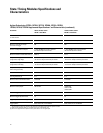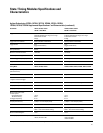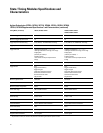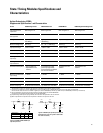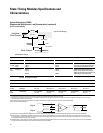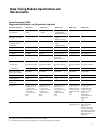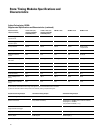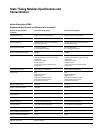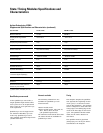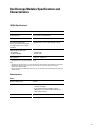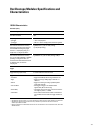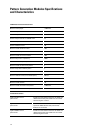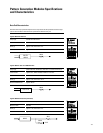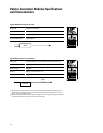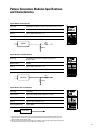
100
State/Timing Modules Specifications and
Characteristics
Agilent Technologies 16760A
Supplemental Specifications and Characteristics (continued)
Eye scan mode 1.5 Gb/s mode 800 Mb/s mode
Maximum clock rate 1.5 Gb/s 800 Mb/s
Sample position range relative +5ns to 10 ns -4 ns to +4 ns
to clock
Sample (time) position resolution 12 ps 12 ps
Sample position (time) accuracy +/- (50 ps + 0.01 * sample position) +/- (50 ps + 0.01 * sample position)
Number of channels 16*(number of modules) 34*(number of modules)-1
Input dynamic range -3.0 Vdc to +5.0 Vdc -3.0 Vdc to +5.0 Vdc
Threshold range -3.0 Vdc to +5.0 Vdc -3.0 Vdc to +5.0 Vdc
Threshold resolution 2 mV 2 mV
Threshold accuracy +/-(30 mV + 1% of setting) +/-(30 mV + 1% of setting)
Equivalent rise time [1] 150 ps 150 ps
Equivalent bandwidth [1] 2.33 GHz 2.33 GHz
Minimum detectable pulse width 500 ps 750 ps
at minimum signal amplitude [1]
Jitter 10 ps RMS 10 ps RMS
Noise floor 25 mV p-p 25 mV p-p
Channel-to-channel skew, maximum 100 ps 100 ps
between any two channels
[1] E5378A, E5379A, and E5382A probes only.
Qualified eye scan mode
In the qualified eye scan mode, a
single qualifier input defines what
clock cycles are to be acquired and
what cycles are to be ignored in eye
scan acquisition.
Qualified eye scan is supported in
the 16760A in 800 Mb/s eye scan
mode only. Qualified eye scan is
only available for double-edged clock
(double-data-rate).
Channels available
The following channels are not
available for qualified eye scan
measurements.
Master module, Pod 1
Master module, Pod 2, Bit 0, Bit 14,
Bit 1, Bit 15, Bit 2, K-clock
(the qualifier input itself).
All channels on all boards other than
the master board are available for
qualified eye scans.
Timing
The analyzer samples the qualifica-
tion signal at the beginning of each
clock cycle (i.e. at the first of each
pair of data transfers). The analyzer
can be configured to treat either the
rising edge or the falling edge of the
clock as the first edge of each clock
cycle. The qualifier should remain
stable for the entire duration of
each burst.
The qualifier must be pipelined
(delayed) by one clock cycle before
transmittal to the analyzer.



